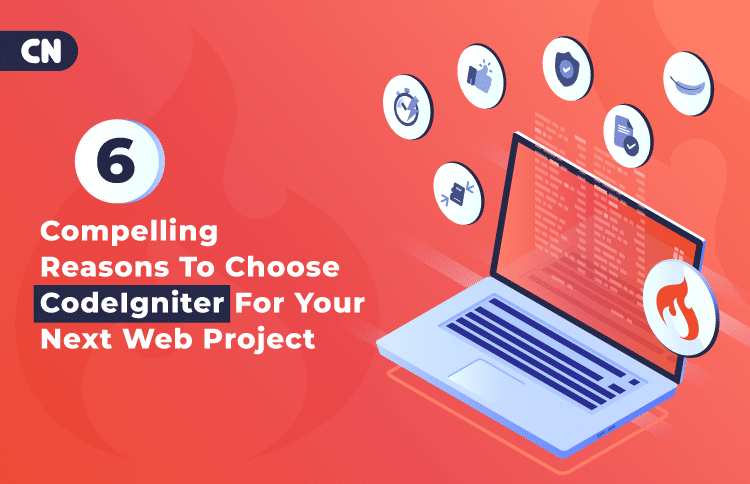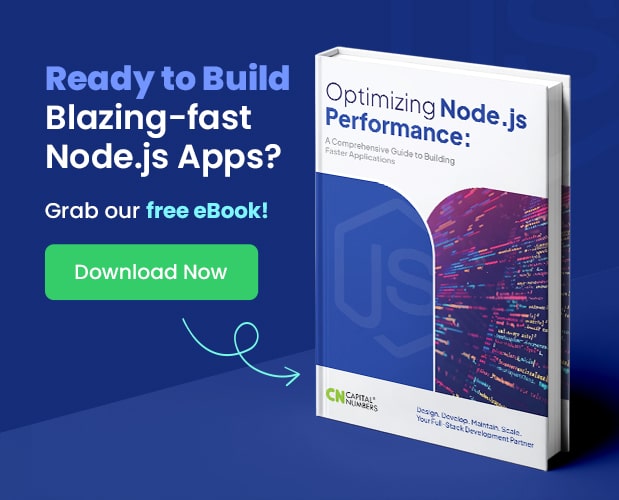6 Compelling Reasons to Choose CodeIgniter for Your Next Project
Table of Contents
Selecting the appropriate framework is a critical decision that impacts the efficiency, scalability, and maintainability of your application. CodeIgniter, a robust PHP framework, distinguishes itself through its lightweight architecture, rapid execution, and minimal configuration overhead. These attributes make it particularly suitable for developers seeking a streamlined development experience without compromising control or performance.
This blog explores the features of the CodeIgniter framework, how it functions, and why it remains a practical and strategic choice for modern web development.
Features of CodeIgniter
Understanding the feature set of a framework is essential before integrating it into your development workflow. CodeIgniter offers a concise yet powerful suite of functionalities that enhance application development. Its design philosophy emphasizes minimalism without sacrificing capability.
Below are the key features that define CodeIgniter’s technical value:
- MVC Architecture Support: It facilitates structured development through the Model-View-Controller paradigm. At the same time, the CodeIgniter framework also allows flexibility for non-MVC implementations when required.
- Efficient Routing System: Provides a straightforward mechanism for mapping URLs to controller functions. This supports both static and dynamic route definitions.
- Robust Form Validation and Input Handling: CodeIgniter includes built-in libraries for validating and sanitizing user input. A major benefit of this feature is that it reduces the risk of common vulnerabilities and ensures data integrity.
- Session and Cookie Management: Offers configurable session handling with support for encryption, expiration control, and secure cookie management.
- Integrated Security Features: Delivers protection against CSRF, XSS, and SQL injection through native security tools. This makes you less dependent on external packages.
- Error Handling and Logging: CodeIgniter enables detailed error reporting during development and configurable logging levels for production environments.
- Extensive Helper Functions and Libraries: It provides reusable components for common tasks such as URL generation, file operations, and string manipulation. By using CodeIgniter, you can streamline your development efforts.
From custom builds to ongoing support, we’ve got you covered. Talk to us now to hire CodeIgniter Developers who bring both speed and reliability.
How CodeIgniter Framework Works
CodeIgniter’s internal workflow is transparent and predictable. You can focus on implementation rather than deciphering framework behavior. Here’s how CodeIgniter processes and executes a typical request:
- Request Configuration: Incoming HTTP requests are routed through the index.php front controller. The routing configuration determines which controller method should handle the request, based on URI patterns defined in routes.php .
This route maps the /users URI to the index() method of UserController:// application/config/routes.php
$route[‘users’] = ‘UserController/index’; - Controller Logic: The designated controller receives the request and acts as the central coordinator. It processes input, invokes models if needed, and prepares data for the view.
The controller loads the model, retrieves data, and passes it to the view:// application/controllers/UserController.php class UserController extends CI_Controller { public function index() { $this->load->model('UserModel'); $data['users'] = $this->UserModel->getAllUsers(); $this->load->view('user_list', $data); } } - Model Interaction: Models encapsulate business logic and database operations. You can load models dynamically within controllers and use them to perform CRUD operations or complex queries.
The model queries the database and returns an array of user records:// application/models/UserModel.php class UserModel extends CI_Model { public function getAllUsers() { return $this->db->get('users')->result_array(); } } - View Rendering: Once data is prepared, the controller loads the appropriate view file. Views are responsible for presenting the output, typically in HTML, and can be composed modularly for reuse.
The view receives the data and renders it in a structured format:<!-- application/views/user_list.php --> <h2>User List</h2> <ul> <?php foreach ($users as $user): ?> <li><?= htmlspecialchars($user['name']) ?></li> <?php endforeach; ?> </ul> - Helper and Library Integration: Throughout the process, you can load built-in or custom helpers and libraries to handle tasks like form validation, session management, or file uploads.
Key Benefits of Choosing CodeIgniter Framework for App Development
Below are six specific reasons why CodeIgniter remains a reliable choice for developers building small to mid-sized applications, prototypes, or projects focused on legacy app modernization:
1. Lightweight Footprint and Fast Execution
CodeIgniter is engineered for speed. Its core system is compact with minimal overhead. Hence, the response times are faster and the memory consumption is also lower. You won’t find unnecessary abstractions or bloated dependencies here. The framework loads only what’s required, and you control what gets included.
For performance-sensitive applications – especially those hosted on shared servers or constrained environments – this lean architecture is a distinct advantage. You avoid the latency introduced by heavier frameworks and retain full control over optimization strategies.
2. Minimal Configuration and Rapid Setup
You can install CodeIgniter and have a functional application structure in place within minutes. There’s no need to configure environment files, dependency managers, or complex bootstrapping logic. The framework uses a single entry point (index.php) and a clear folder structure that’s easy to navigate.
Configuration is handled through simple PHP arrays, not YAML or JSON. You define routes, database settings, and session parameters in well-documented config files. This reduces setup time and lowers the barrier for onboarding new developers.
3. Flexible MVC Implementation
CodeIgniter supports the Model-View-Controller pattern but doesn’t enforce it rigidly. You’re free to structure your application as needed – whether that means bypassing models for simple views or extending controllers with custom logic.
This flexibility is valuable when working on projects that don’t fit neatly into strict architectural patterns. You can start small and refactor into a more formal MVC structure as the application grows.
4. Built-in Security Features
The framework includes native protection against common vulnerabilities such as Cross-Site Request Forgery (CSRF), Cross-Site Scripting (XSS), and SQL Injection. You can enable CSRF protection across the entire application or per form, sanitize inputs using built-in functions, and rely on parameterized queries via Active Record to prevent injection attacks. These features are integrated into the core, so you don’t need to depend on third-party packages or write custom middleware.
5. Clear Documentation and Active Community Support
CodeIgniter’s documentation is structured and concise. It provides direct access to configuration guidelines, usage patterns, and implementation examples that are applicable to real-world development scenarios. The content is logically organized, which allows you to locate and apply relevant information without delay.
While the community may be smaller than that of more mainstream frameworks, it remains engaged and responsive. Forums, GitHub repositories, and third-party resources offer consistent support, particularly for troubleshooting and edge-case implementations. As a result, you reduce time spent on trial-and-error and accelerate delivery cycles.
6. Stable Architecture with Long-Term Maintainability
The architecture of the CodeIgniter framework is stable and predictable. These two qualities are essential for long-term application maintenance. Its loosely coupled components, clear directory structure, and minimal reliance on external dependencies reduce the likelihood of version conflicts and technical debt over time. You retain full control over how components interact, which simplifies debugging and refactoring.
Unlike frameworks that frequently introduce breaking changes or shift architectural paradigms, CodeIgniter maintains backward compatibility and a consistent development model. This makes it suitable for projects that require sustained development across multiple release cycles or handoffs between teams.
When to Use CodeIgniter
CodeIgniter is highly effective under the following conditions:
- Rapid Prototyping Requirements: When you need to build and iterate quickly without extensive setup or configuration, select CodeIgniter over other options.
- Small to Mid-Sized Applications: CodeIgniter framework offers a clean and efficient framework for projects that don’t require enterprise-level complexity.
- Shared Hosting Environments: If your deployment target has limited resources or lacks support for Composer-based dependency management, CodeIgniter’s lightweight footprint and self-contained architecture are advantageous.
- Projects Requiring Fine-Grained Control: If you prefer direct access to configuration and logic without being constrained by rigid conventions, CodeIgniter is the best option.
- Legacy Codebase Integration: When modernizing older PHP applications, CodeIgniter’s compatibility with traditional coding practices allows for incremental refactoring without a complete rewrite.
You May Also Read: Upgrading from CodeIgniter 2 to 4: Challenges and Solutions
Conclusion
Choosing a framework is a strategic decision that should reflect the technical demands and long-term objectives of your project. CodeIgniter’s stable architecture, minimal configuration overhead, and well-documented feature set make it a perfect choice for developers. Whether you’re initiating a new build or optimizing an existing application, CodeIgniter provides the much-needed structural simplicity and operational flexibility. This enables you to deliver robust, scalable solutions with confidence.
FAQs
1. Can I use Composer with CodeIgniter even though it’s lightweight?
Yes. CodeIgniter supports Composer for dependency management. You can install third-party packages just like in other modern PHP frameworks, even though its core doesn’t depend heavily on Composer.
2. How does CodeIgniter handle database migrations?
CodeIgniter includes a migration class that allows developers to version their database schema. You can create, update, and rollback database structures using simple migration files.
3. Is CodeIgniter suitable for building RESTful APIs?
Yes. CodeIgniter provides routing, controllers, and output handling that make building REST APIs easy. Developers often combine it with libraries or extensions to simplify authentication, rate limiting, and JSON formatting.
4. Can CodeIgniter scale for larger applications, or is it only for small projects?
While it shines in small to mid-sized apps, CodeIgniter can also scale with proper architecture and optimization. However, it may lack some enterprise-grade features out of the box compared to Laravel or Symfony.
5. How does CodeIgniter perform compared to Laravel or Symfony?
CodeIgniter generally outperforms heavier frameworks in terms of raw speed and memory usage due to its lean architecture. However, Laravel and Symfony may provide more built-in tools and integrations at the cost of extra overhead.















